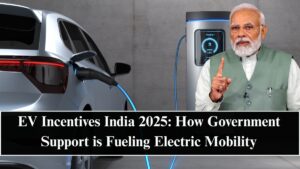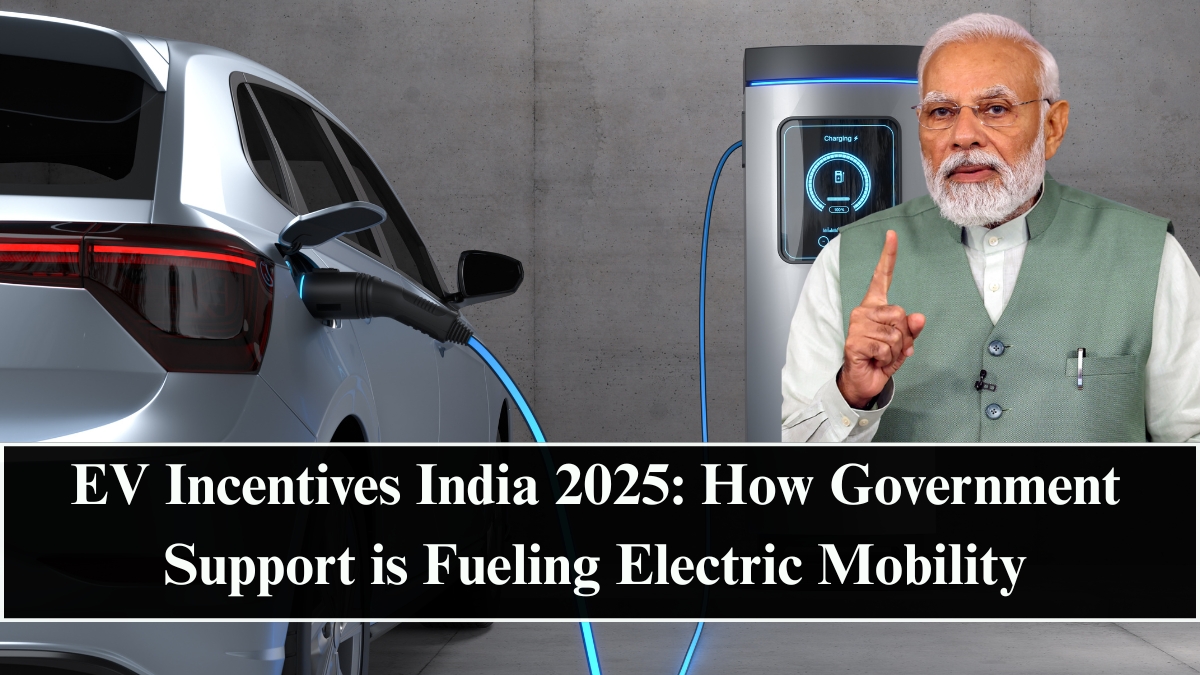India’s electric vehicle (EV) revolution is no longer just a dream — it’s a full-fledged national movement. EV Incentives India 2025 are reshaping the country’s mobility landscape, enabling faster adoption of electric cars, two-wheelers, and commercial vehicles through a mix of subsidies, tax exemptions, and infrastructure initiatives. With strong government backing, automakers and consumers alike are now embracing this green transformation at scale.

Government Policies Driving Electric Mobility
At the heart of EV subsidies in India lies the continuation and expansion of schemes like FAME-II (Faster Adoption and Manufacturing of Hybrid and Electric Vehicles). The program has been pivotal in offering upfront subsidies on EV purchases, with particular focus on two- and three-wheelers — the backbone of Indian transportation. By 2025, several states have also introduced their own complementary incentives, including road tax exemptions, registration fee waivers, and additional purchase rebates.
In parallel, the Production Linked Incentive (PLI) Scheme for the automobile and battery sector has strengthened the supply chain by encouraging domestic manufacturing of lithium-ion cells, motors, and EV components. This synergy between consumer incentives and industrial policy has made electric mobility a viable choice across segments.
Tax Breaks and Financial Benefits for Buyers
One of the most attractive elements of the 2025 EV incentive policy is the financial relief provided to individual buyers. Under Section 80EEB of the Income Tax Act, buyers of electric vehicles can claim up to ₹1.5 lakh in tax deduction on interest paid for EV loans. Moreover, GST on electric vehicles remains at just 5%, compared to 28% on conventional vehicles — a massive incentive that directly impacts affordability.
Many state governments, including Delhi, Maharashtra, and Tamil Nadu, also provide direct cash incentives ranging from ₹10,000 to ₹1 lakh, depending on the vehicle type and battery capacity. Such e-vehicle incentives are designed to make EVs not just eco-friendly but economically smart choices too.
Charging Infrastructure & Energy Ecosystem
No EV transition can succeed without robust charging infrastructure, and 2025 marks a year of accelerated progress. The National Electric Mobility Mission Plan (NEMMP) and the Charging Infrastructure for Electric Vehicles (CIEV) initiative have laid the groundwork for more than 100,000 public charging stations nationwide. Private players like Tata Power, Ather Grid, and ChargeZone are collaborating with state utilities to expand fast-charging networks along highways and city corridors.
Meanwhile, energy companies and startups are exploring battery-swapping models and renewable-powered chargers, ensuring that the infrastructure evolves alongside growing EV demand. Together, these developments create a seamless user experience for new EV adopters.
EV Adoption in Different Segments
While personal EVs have gained attention, 2025 is also witnessing a surge in commercial adoption. Fleet operators, ride-hailing services, and logistics firms are transitioning to electric mobility due to reduced operational costs and supportive government frameworks. The rise of e-buses and e-trucks under state transport projects has further boosted visibility of EV technology on Indian roads.
Additionally, rural areas are joining the movement with affordable electric two-wheelers and e-rickshaws, supported by microfinance and government-backed programs. The combination of subsidies, accessible financing, and widespread awareness has democratized EV ownership like never before.
Challenges and the Road Ahead
Despite progress, challenges remain in terms of battery recycling, raw material sourcing, and grid capacity. However, government initiatives such as the Battery Waste Management Rules 2022 and incentives for localized lithium and cobalt alternatives are paving the way for sustainable growth. By integrating EV policy with renewable energy goals, India aims to reduce oil imports and carbon emissions simultaneously.
The government’s ambitious target of achieving 30% EV penetration by 2030 now seems within reach, thanks to the comprehensive push in 2025. As automakers continue to launch more affordable, high-performance models, consumer confidence is only set to grow.
The Bigger Picture
The EV incentives in India in 2025 are not merely about financial subsidies — they represent a national commitment to clean energy, innovation, and self-reliance. With coordinated policy, technology, and infrastructure development, India is turning its EV dream into a sustainable, long-term reality.
FAQs
What incentives are available for EV buyers in India in 2025?
Buyers can avail of purchase subsidies under the FAME-II scheme, tax deductions on EV loan interest up to ₹1.5 lakh, and reduced GST at 5%. Many states also offer additional incentives like road tax waivers.
Which states offer the best EV subsidies in 2025?
States like Delhi, Maharashtra, Gujarat, and Tamil Nadu offer some of the most generous EV purchase incentives and infrastructure support policies.
Are there incentives for EV manufacturers in India?
Yes, manufacturers benefit from PLI schemes that promote local production of batteries and EV components, helping reduce overall vehicle costs.
How is the government improving EV charging infrastructure?
The government and private companies are collaborating to install fast-charging and battery-swapping stations across major cities, highways, and rural hubs under national and state-level EV programs.
What is the target for EV adoption by 2030?
India aims for 30% of all vehicle sales to be electric by 2030, supported by ongoing subsidies, tax incentives, and infrastructure expansion.
Click here to know more.
